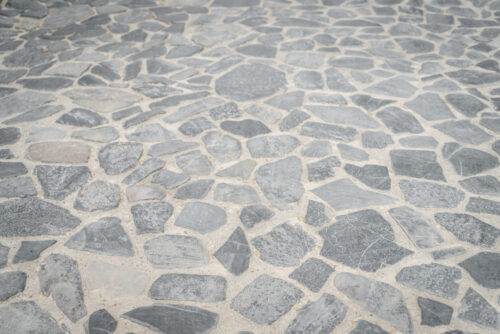What is vitrified porcelain paving?
Yes, there is a difference between the two types although that might not seem immediately apparent. Where they are similar is that both are fired at high temperatures to produce paving stones that are extremely durable and strong
Yes, there is a difference between the two types although that might not seem immediately apparent. Where they are similar is that both are fired at high temperatures to produce paving stones that are extremely durable and strong. However, vitrified porcelain is more technologically advanced than the more common type of porcelain slab.
How? Well, vitrified porcelain paving is the result of innovations in hydraulic pressing, altered ingredients and higher baking temperatures.
The materials from which it is made – clays, feldspar, and siliceous sands - are heated so intensely (at around 1,200 degrees Celsius) that they turn into a glass like substance. When cooled, it becomes compacted and super dense. This is what makes vitrified porcelain paving so hardwearing, and therefore an excellent option for high-traffic areas like paths and patios.
Because it is heated at such high temperatures, it also has an exceedingly low water absorption rate of less than 0.5 per cent, making it ideal material for outdoor projects.
Benefits of vitrified porcelain paving
Anti-slip
The texture of vitrified porcelain pavers makes them anti-slip, which means they are excellent for high-footfall areas like patios and pool surrounds.
Resistant to thermal shock
Vitrified porcelain paving has a lower porosity than standard ceramic tiles, so it works perfectly in outdoor areas where frosts occur because it is resistant to thermal shock.
High resistance to loads
Because of their density, slabs made from vitrified porcelain are strong enough to withstand weighty objects.
Wider choice
Porcelain tiles come in a broad range of s. The durability of vitrified porcelain means that it can be polished to a high shine, given a matte or textured effect, and can be digitally printed to create a look that will compete with any natural stone effect.
Easier to work with
Vitrified porcelain paving slabs are pretty straightforward to work with because they are rectified - cut in regular sizes with clean crisp edges. This means that they can be laid with slimmer, sleeker joints for a smoother more on trend look.
Easy to maintain
Because their manufacturing process binds molecules together, vitrified porcelain pavers will be non-porous which means liquid or air cannot pass through them. This results in their being easy to maintain. They also do not require any sealing as is the case with other types of natural stone.
Scratch-resistant
The hardness of the material makes porcelain tiles extremely resistant to scratches and wear from foot traffic.
Resistant to salts and acid
Because vitrified porcelain paving is so dense and less porous than natural stone, it has a higher resistance to acid algae and mould.
More resistant to staining
Vitrified porcelain paving has low porosity which means that spills are less likely to soak into them causing staining.
Perfect for bringing the outside in
The versatility of vitrified porcelain paving makes it ideal if you want the seamless finish required to create the flow between an indoor space such as a kitchen diner or conservatory and the outside patio. What designers would describe as “bringing the outside in”.
How do I clean vitrified porcelain paving?
Even though we have identified that vitrified porcelain paving is easy to look after, that doesn’t mean you need to do nothing to ensure it looks as beautiful as the day it was installed.
Like anything outdoors, it will eventually get covered in dust, debris, muddy footprints, spills and even bird droppings.
The good news is that while you can buy specialist cleaning solutions to tackle these problems, regular mopping with warm soapy water will probably do the job just as well.
What we must emphasise is that once you have soaped the tiles or used a pH neutral detergent to mop them, you must ensure they are rinsed thoroughly.
Do not let the cleaning solution dry out because this will create water marks. To remove more stubborn stains, you can gently use a scrubbing brush.
Afterwards all you need to do is gently buff them with a soft lint free cloth to restore shine.
Why choose vitrified porcelain paving slabs for your outdoor area?
As you can see, there are numerous reasons why you should choose vitrified porcelain paving for your outdoor project.
But what you might want to consider is how appropriate they are for your particular project.
For anyone improving their outdoor space with a paved surface, their priority must be how it will look. As we’ve explained above, vitrified porcelain paving is versatile in appearance and can be made to emulate many other types of stone, but it won’t have the character of a natural type of stone.
You also need to consider how the flooring area will be used once it has been laid. Basically, if you are looking for an outdoor paving material that can really withstand heavy footfall, scuffs, scratches, and chips then it will serve you well.
Still want to know more?
If you are considering whether to update your outdoor space, why not check out our range of high-performance porcelain paving.

 Log Out
Log Out 









The information below is required for social login
Login
Register
Fill in the form below to create your new account